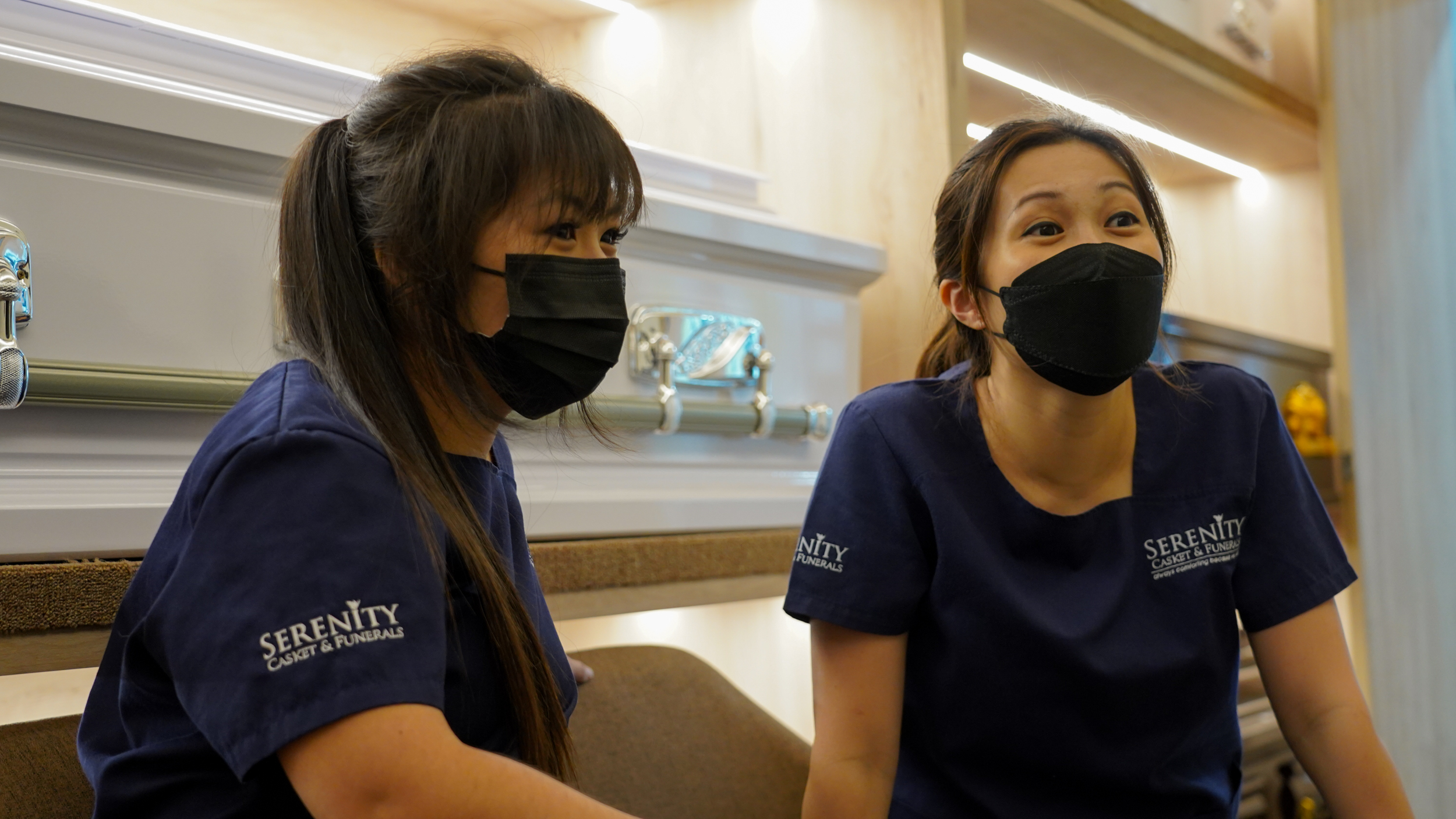Follow us on Telegram for the latest updates: https://t.me/mothershipsg
“Is this the first case you received today?” I ask Sarah Ang.
The lead embalmer at Serenity Casket and Funerals doesn’t reply, only turning to look at her fellow embalmer Nicole Chong who returns a knowing smile.
“Nicole is very scared of people asking this question leh! She has been working past midnight these few months!” Sarah replies with a laugh.
I immediately apologise, but Nicole brushes it off, “Never mind lah, if there is a case we will just accept and do it. We don’t have superstitions one!”
Embalming is definitely not a job for the faint-hearted.
I watch Ang deftly make an incision on the left upper thigh of the deceased, reaching for the femoral artery. My stomach churned. Thank goodness I hadn’t had a heavy breakfast before coming to this interview.
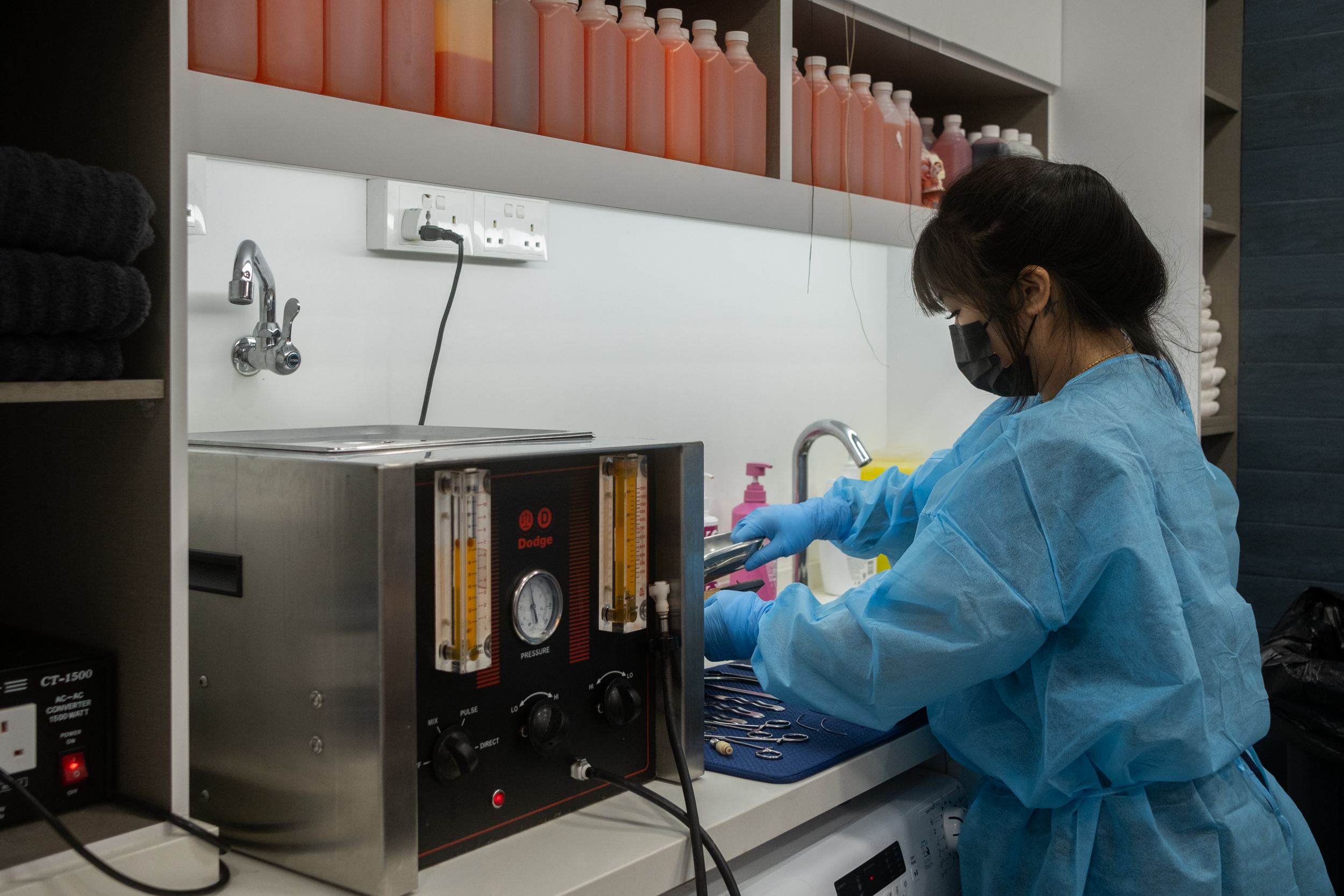 Chong preparing the tools needed to embalm the deceased. Image by Andrew Koay.
Chong preparing the tools needed to embalm the deceased. Image by Andrew Koay.
The small embalming room is neatly organised, with bottles of formaldehyde lining the shelves at the back of the room and towels neatly stacked on the other side of it. Posters of the human anatomy line the wall on the right side and the faint smell of chemicals lingers in the air.
This is the workplace Ang and Chong come to everyday, where they work to make sure they give the deceased a dignified farewell.
Inspired to learn the craft of embalming
Prior to her taking on the role of lead embalmer at Serenity Casket and Funerals, Ang was mostly involved in funeral directing at her late father’s funeral parlour.
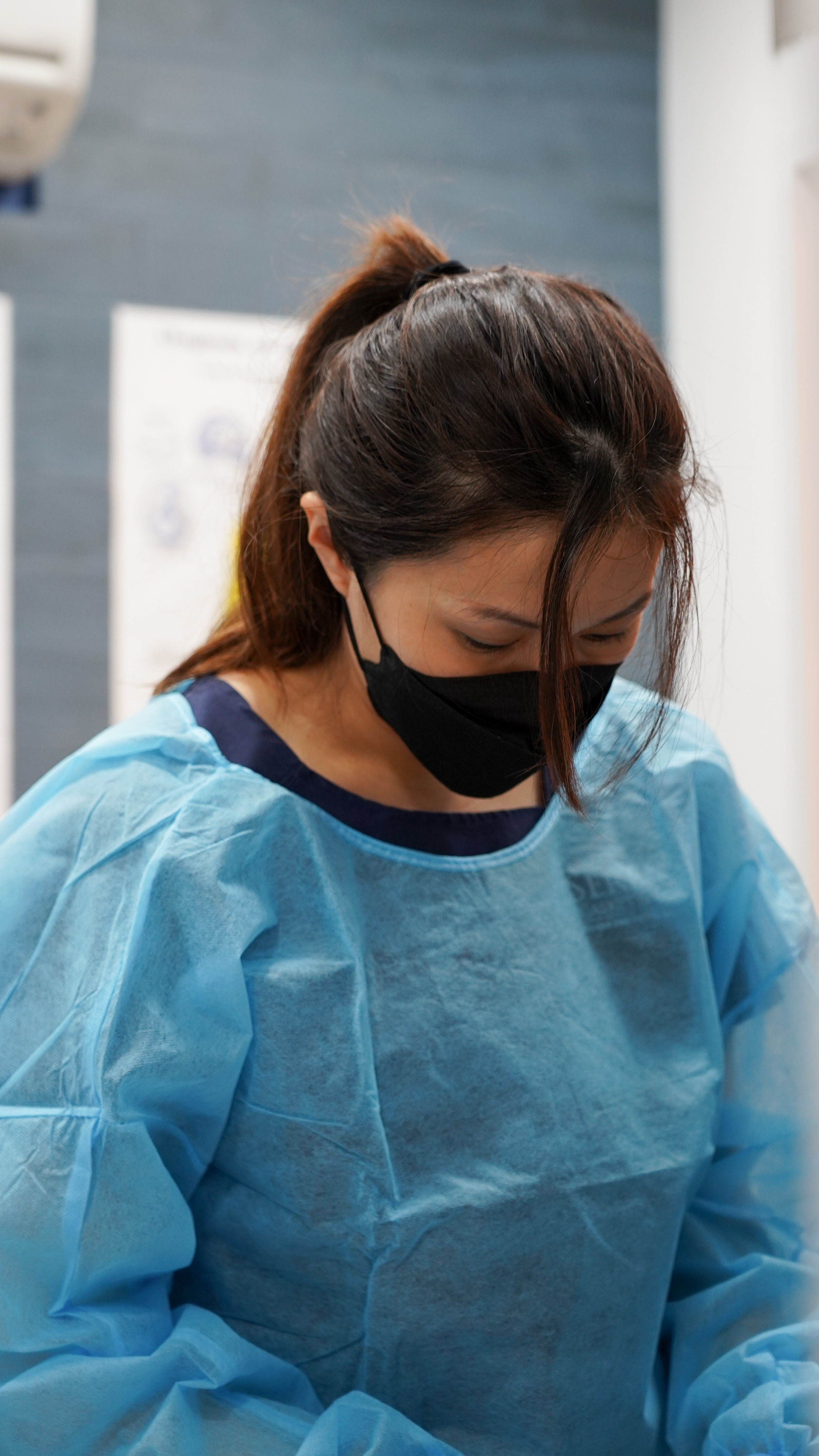 Ang embalming the deceased. Image by Andrew Koay.
Ang embalming the deceased. Image by Andrew Koay.
Being the youngest daughter of the late “Coffin King” Ang Yew Seng, Ang has long been involved in the funeral trade. Before her stint at Serenity Casket and Funerals, Ang was a funeral director at her father's funeral parlour.
Today, her oldest sister helps to run the Ang Yew Seng Funeral Parlour alongside their mother, and her second sister also has her own company, The Life Celebrant.
Ang was inspired to learn the craft of embalming after witnessing firsthand the expert skills of an Australian embalmer, Andrew Oldman, who was employed by the Ang Yew Seng Funeral Parlour.
He’s the one who inspired me. He makes embalming so artistic and so gentle and peaceful, as compared to the other embalmers back then.
In 2014, Ang left for New Zealand to study the art of embalming, earning her embalming certification from the Wellington Institute of Technology (WelTec) a year later.
When she returned, her sister-in-law Nicole Chong, expressed interest in learning the ropes from her. And so, at the tender age of 20, Chong started her apprenticeship under Sarah, earning herself the title of “Singapore’s youngest female embalmer” in 2017.
Like Ang, Chong was also influenced by her family to enter the funeral trade, helping out at her father's funeral parlour Chng Hoon Casket when she was younger.
Today, both of them are registered embalmers under the NEA’s licensing scheme. The cases they have taken on range from post-mortem to severely decomposed bodies, with Ang and Chong each handling more than 3,500 and 2,500 bodies to date.
Embalming procedures
The pair maintains that embalming requires not only practical experience, but theoretical knowledge about human anatomy as well, says Ang.
"There are steps that we always follow. There’s a guideline in the textbook, and we always follow the guide. If there are challenging cases, theory and experience both come in to help."
I observe as Chong attaches a thin tube to an artery before switching on a machine which pumps chemicals into the body, giving the skin a brighter, more life-like hue.
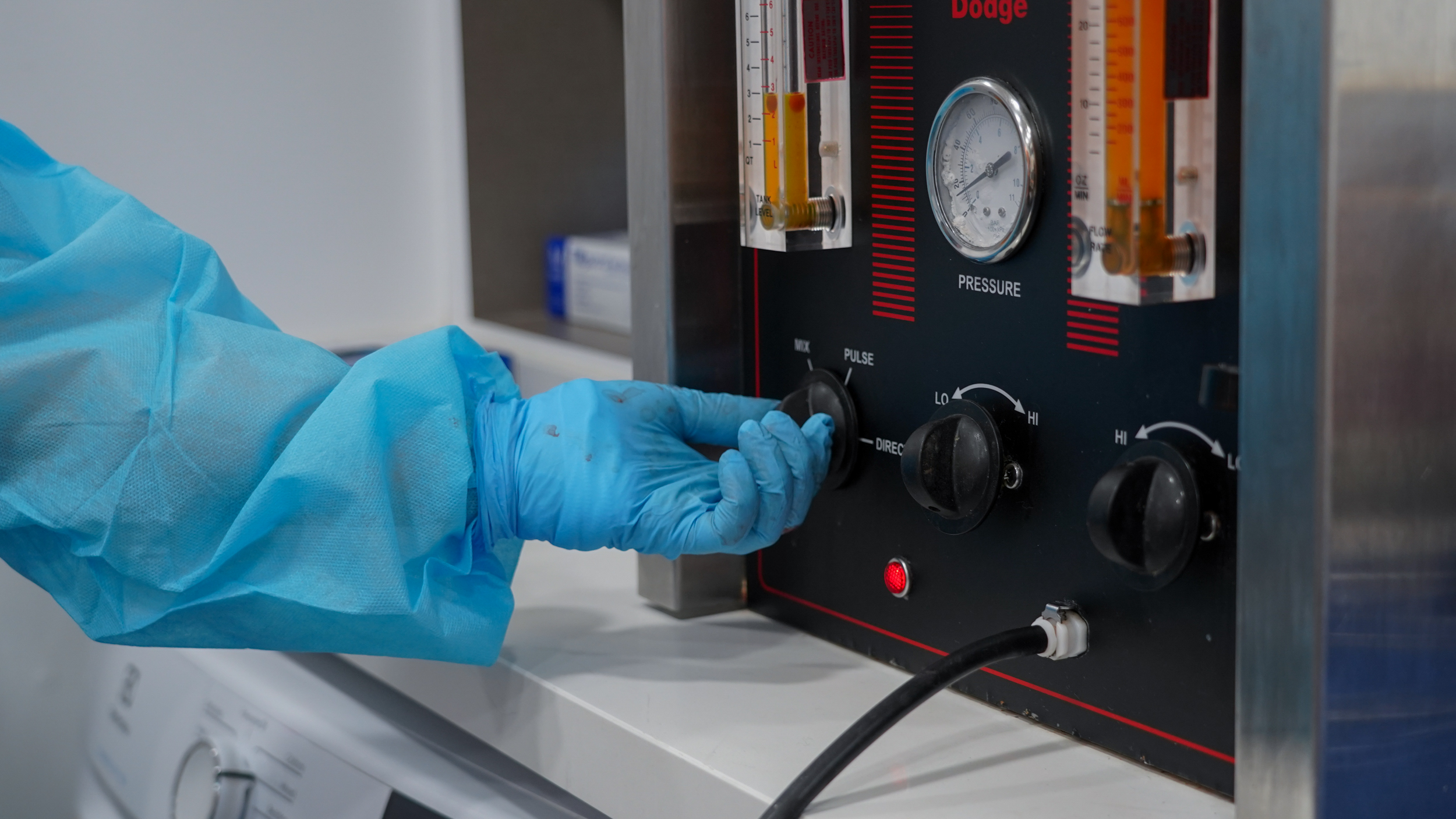 Switching on the machine. Image by Andrew Koay.
Switching on the machine. Image by Andrew Koay.
The effect is almost instantaneous, with the left leg of the deceased looking much more radiant than the right one after a few moments.
"The formaldehyde we use is imported from Canada. It includes dye and moisturising agents which can help to make the skin look better," Ang informs me.
Although the chemical they use is much more expensive to import than the chemicals used by other funeral parlours, Ang insists on only utilising this specific formaldehyde when doing embalming for the deceased.
There are cheaper chemicals out there, but I believe in only using high-quality chemicals when doing embalming. If you ask me to do embalming with other chemicals, I will not do it because the results will be very different.
I notice Chong making another incision on the left-upper arm of the deceased, inserting the tube into the cut before rhythmically massaging the arm. Chong explains there is a blockage in an artery and she has to "raise" its so that the formaldehyde can be distributed more evenly across the arm.
 Ang and Chong rhythmically massaging the deceased's arm. Image by Andrew Koay.
Ang and Chong rhythmically massaging the deceased's arm. Image by Andrew Koay.
"I think [the deceased] had a stroke previously, that's why it's hard for the formaldehyde to flow," Ang adds.
Challenging cases
Having encountered a wide range of cases across the years, the pair are adept at improvising and combining their theoretical knowledge and practical experience on the job.
A lot of the processes and methods utilised are industry secrets, but the duo share some challenging cases that they have handled in the past.
Recalling a previous case where the deceased's face was split apart after a suicide attempt, the pair share how they came up with a creative solution to stitch the face back together: Dental floss!
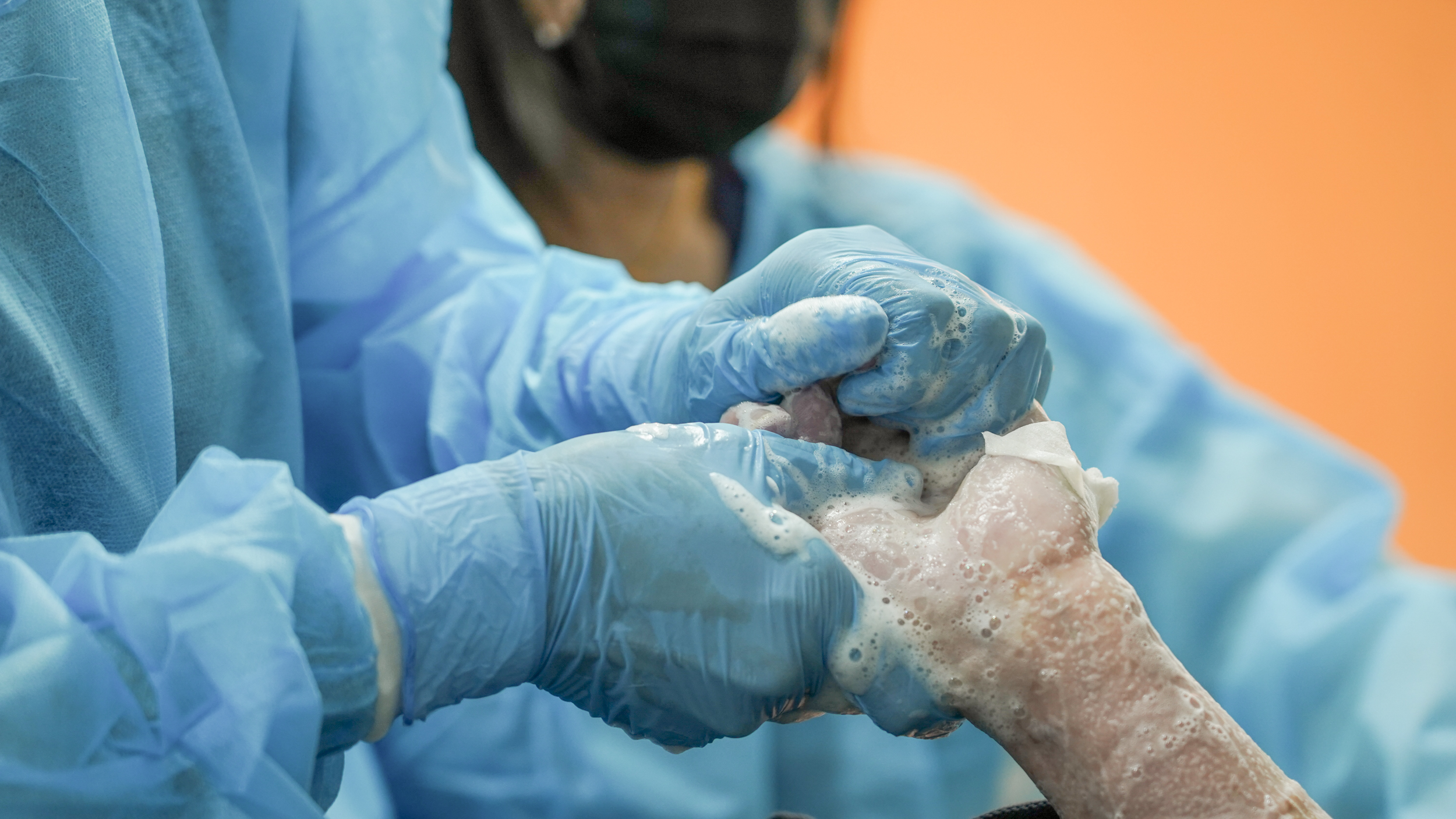 Washing the deceased. Image by Andre Koay.
Washing the deceased. Image by Andre Koay.
While the method may raise some eyebrows, Chong explains that, unlike conventional thread, using dental floss ensures that the suture marks are “not so obvious because it is very fine”.
In another instance, Chong had to construct a nose for a deceased who had suffered from nose cancer. Using a "metal spatula" to shape the nose bridge, she spent a whopping five hours fashioning the nose from scratch.
"That was the toughest [case] I ever handled. I had to be very accurate and precise," she says.
Embalming during Covid-19
These days, Ang has also implemented stricter measures in the handling and embalming of bodies in line with regulations set by the National Environment Agency (NEA).
Before they move the deceased onto the embalming table, the duo have to disinfect the metal table as well as the body bag containing the body.
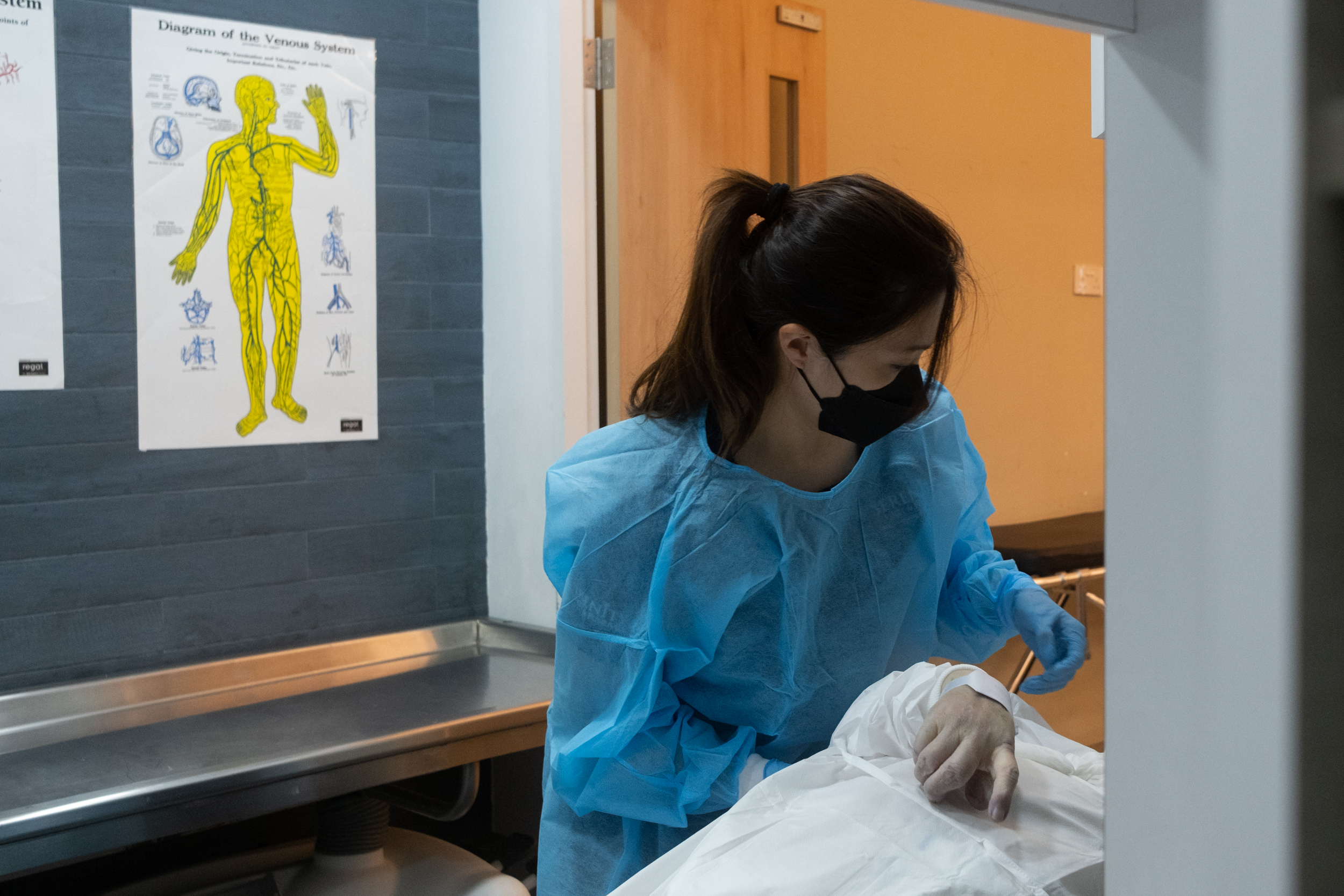 Ang removing the deceased from the body bag. Image by Andrew Koay.
Ang removing the deceased from the body bag. Image by Andrew Koay.
But for those who have died from Covid-19, the body cannot be brought down to the parlour to be embalmed as the deceased may still be infectious. Instead, the body will be bagged in a single leak-proof bag before being placed straight into the casket at the hospital.
If the date of demise is within the first 28 days of contracting Covid-19 but the deceased is deemed as non-infectious by the doctor, embalming cannot be performed but procedures like make-up and washing can still be done.
Contrastingly, if the patient died at least 28 days after contracting Covid-19, Ang and Chong are able to help embalm the deceased.
A demanding job
Given the unpredictable nature of their job, the pair are used to working irregular hours.
Ang explains how there is usually “no warning” before a body is sent to them to be embalmed.
Imagine when you are preparing to go out, then another body comes in. Then when you clean everything up already, suddenly another body comes in. You cannot control the timing.
The embalming process can take about two hours, which often results in them working through the night.
Ang also points out the physically demanding aspects of their job. As one of the few female embalmers in Singapore, Ang and Chong maintain that they do not have it easier than their fellow male colleagues.
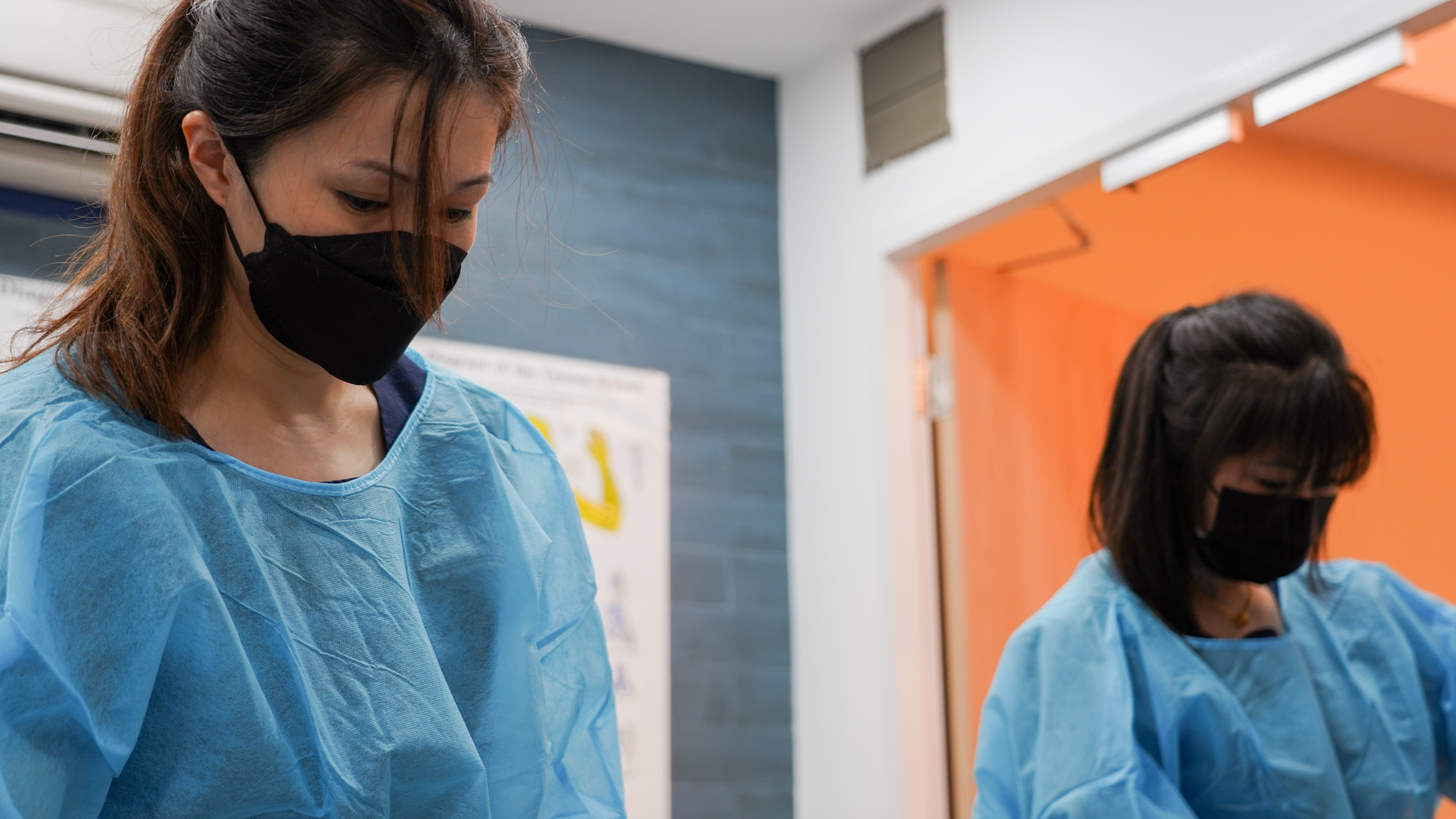 The duo working together. Image by Andrew Koay.
The duo working together. Image by Andrew Koay.
I notice that the body that they're working on is of a larger build. But even with the two of them, I hear them quietly grunting as they turn the body over to wash the back.
But the gut-churning anecdotes they share with me are the ones that truly demonstrate their mental grit.
“I will never forget that smell”
Chong relates a case where the body was so severely decomposed that “maggots were pouring out from the head.” The worst part? When she flipped the body over, “the whole back was nothing but maggots.”
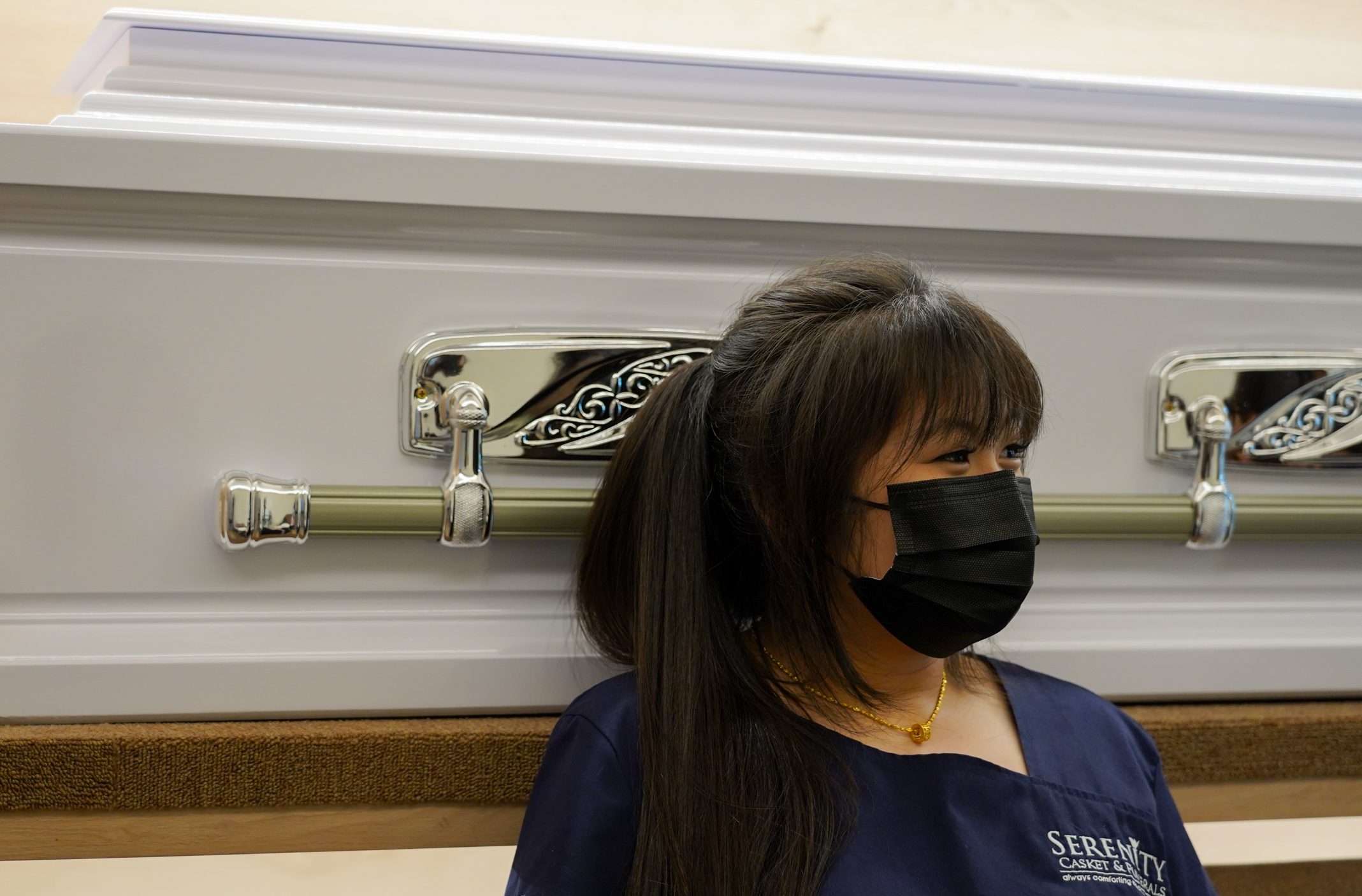 Chong relating her experience. Image by Andrew Koay.
Chong relating her experience. Image by Andrew Koay.
The most memorable case for Ang occurred in 2019, where the deceased had died of a heart attack on a cargo ship. By the time she received the body, the condition was so bad that she almost broke down.
The smell was too much for me to handle. The skin had turned green and was slipping off. The smell stays on your hair and skin, even after showering. Wah, I will never forget that smell.
“Actually you want to know what it smells like? I think we have one body at the back,” Chong asks me eagerly.
“Err, sure,” I reply apprehensively.
As I follow her to the adjoining room, I smell a faint stench that is reminiscent of meat that had gone bad. As she pulls back the curtains, the pungent stench of rotting meat hit my nostrils like a sledgehammer.
Imagine the stench of meat that hasn’t been stored in the freezer for a week, but 10 times stronger. Even though the body is double-wrapped, the stench still permeates the room.
I will never forget that smell.
Motherhood and embalming
On average, the duo can handle up to five bodies a day, depending on the urgency and complexity of each case. The job is rigorous and demanding, often disrupting their family plans.
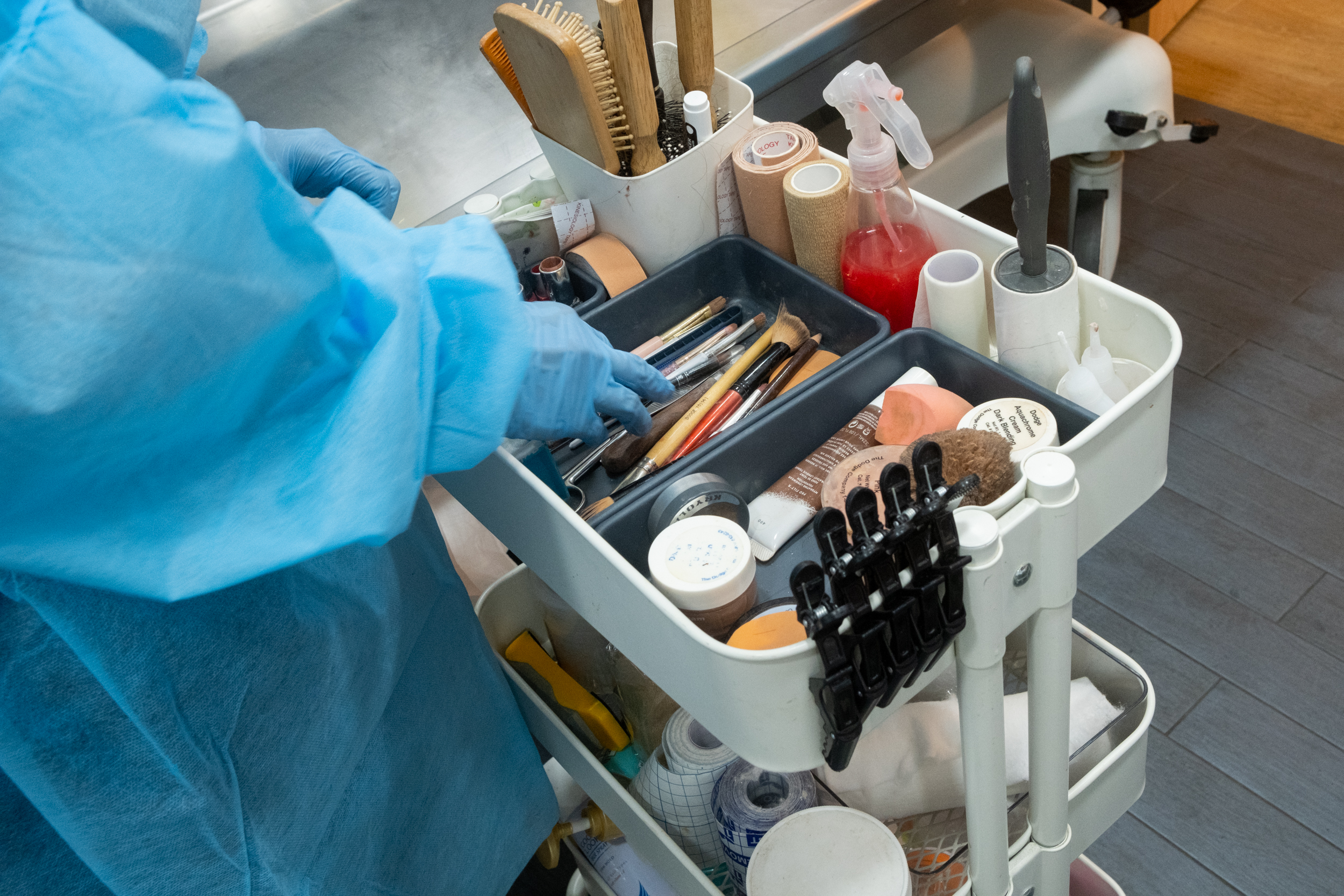 Make-up to be used on the deceased. Image by Andrew Koay.
Make-up to be used on the deceased. Image by Andrew Koay.
When they are not working, Ang and Chong always try to spend time with their children. Chong, who has two daughters aged four and two, states that she tries to “give them all [her] attention” when she has free time.
But her plans do not always work out. Once, she took her daughters to Haw Par Villa but had to leave halfway after receiving an urgent call from her workplace.
She has explained to her children the nature of her job so that they would understand. “I will always try to make it up to them afterward and give them my time and attention when I can,” she says.
The same goes for Ang, who has three children, the youngest of which is three-months old. Last week, she brought her two older children to their first-ever movie experience and even then, she says that she decided on it at the “last minute”.
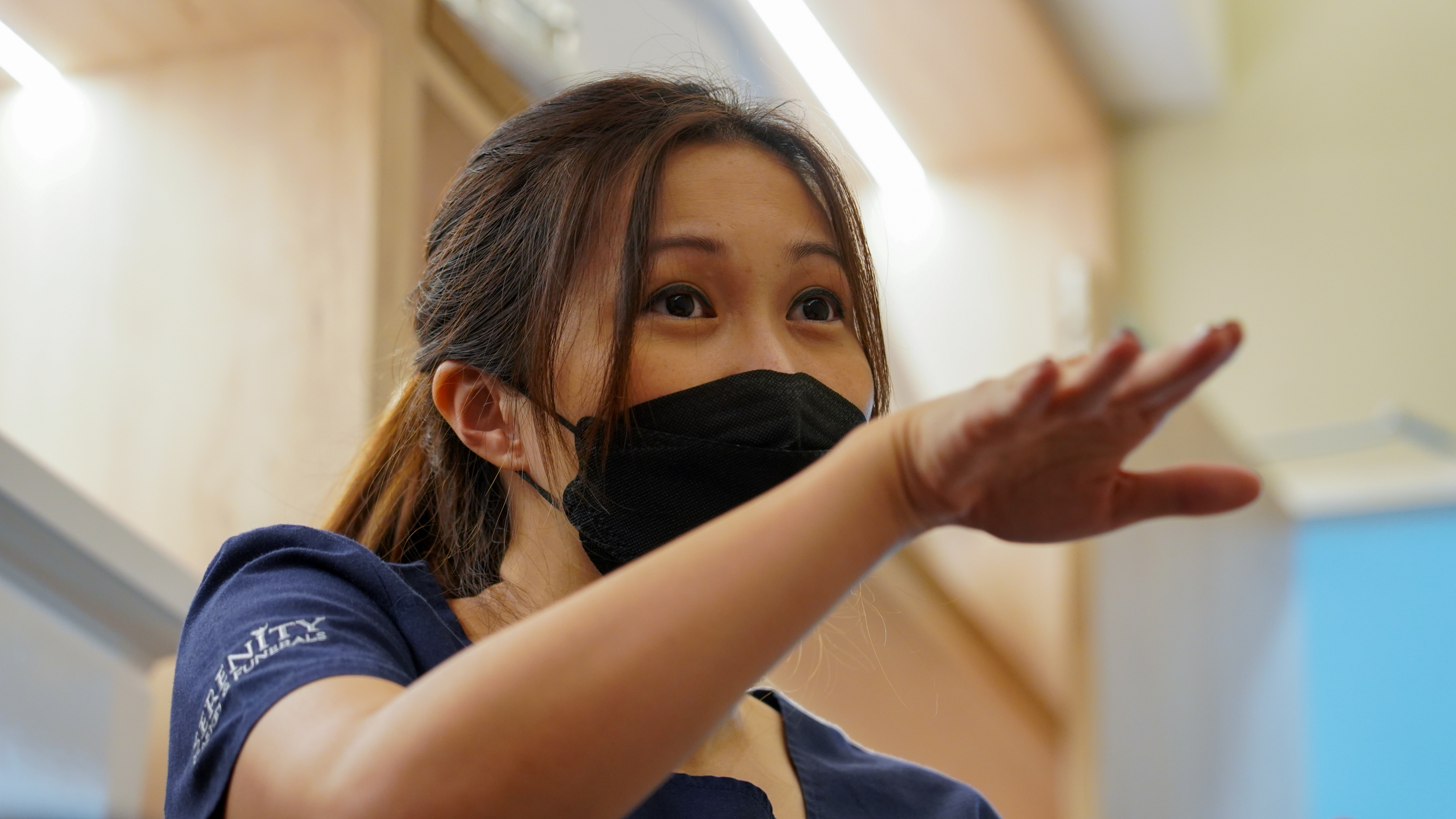 Ang sharing about the embalming process. Image by Andrew Koay.
Ang sharing about the embalming process. Image by Andrew Koay.
She reveals that she only stopped working when she was five months into her third pregnancy. Sensing my surprise, Ang explains:
It’s not really about the dead body, or pantang. [I stopped] because it’s not safe for pregnant women to be around the chemicals that we are using.
She returned to work just two weeks after the birth of her daughter, forgoing the four-month maternity leave she was entitled to entirely.
“A very fulfilling job”
As their work is done “behind-the-scenes”, the pair says that embalmers are often the “forgotten ones”.
Normally people will thank the funeral directors, they hardly thank the embalmer. They won’t know who is behind-the-scenes. It’s very common.
But once in a while, they get messages from family members who thank them for helping to make the deceased look good. Some have even requested to meet them in-person to express their appreciation for their hard work.
Such words of appreciation motivate the pair to keep going everyday, sticking by their principle of “no short-cuts” in order to give the deceased a dignified farewell.
Ang says:
"Even though it can get very tiring, but at the end of the day, it’s a very fulfilling job. To be able to create a memory picture of the deceased for their family is very fulfilling. We should respect the dead and give them a proper send-off."
As we conclude our interview, Ang receives news that two more bodies will be arriving at the funeral parlour. Immediately, I think of what Chong and Ang said about superstitions at the start.
Coincidence? Maybe. But one thing is for certain: these ladies are the true epitome of resilience and are here to stay for the long-run.
Top image by Andrew Koay.
Follow and listen to our podcast here
If you like what you read, follow us on Facebook, Instagram, Twitter and Telegram to get the latest updates.
